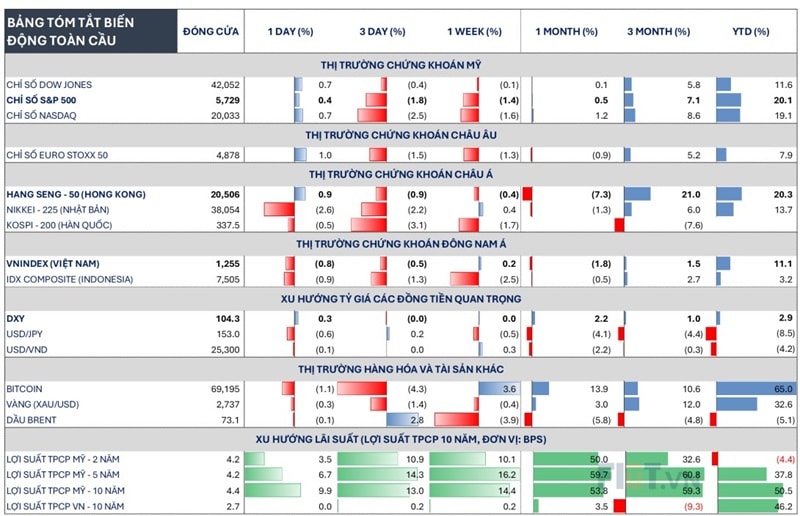Vietnam stock market: Limited pressure for a big correction
Mr Doan Minh Tuan, Head of Research & Investment at FIDT, stated that the VN-Index's short-term trend has continued to drop over the last two weeks, indicating both global and domestic risks.
Factors Causing Negative Volatility
Last week, the VN-Index fell from the 1280-1300 area, reverting to a narrow accumulation at 1250 (-10). Despite the short-term corrective trend, heightened global risks, and the State Bank of Vietnam's continued liquidity tightening, the VN-Index experienced technical recovery, but with very low trading volumes, reaching an average level not seen in recent years (10,000-12,000 billion VND), indicating that market sentiment remains cautious in light of current risks. Despite approaching the "attractive" 1,240-1,250 zone, the VN-Index concluded the week down at 1,254, indicating a slowing recovery momentum.
.jpg)
Market sentiment remains cautious despite the VN-Index nearing an “attractive” price range.
A notable aspect of the last week was the low trade volume during recovery sessions; this is the clearest indication that cash flow circumstances remain unstable and have yet to adequately reflect short-term dangers. Because of the dismal sentiment, most stocks rebounded marginally before immediately stalling, with selling pressure rising near the close of the session.
Market breadth is quite limited. Recovery sessions mostly concerned large-cap companies with minimal liquidity (such as FPT, VGI, VCB, and CTG), while most stocks continued to fall. One factor is the market's poor cash flow circumstances, along with lackluster Q3 financial performance across numerous industries.
"A preliminary analysis shows that Q3 financial results for listed companies have been largely negative, marking this as the worst earnings season in three quarters. The market lacks standout sectors, with uncertain EPS growth prospects and heightened risks heading into late 2024. After analyzing various sectors and companies, we have a negative outlook for certain industries: banking (BID, MBB, ACB); securities (most securities stocks underperformed expectations); Steel (HSG, NKG); and large-cap (PNJ, GVR, MWG, PNJ)," said Mr Doan Minh Tuan.
Additionally, some large companies face short-term individual risks that have driven their stock prices down sharply, impacting the broader market—examples include VHM (VIC – VRE) and MSN.
Global Risks on the Rise, with No Short-Term Solutions
Starting the week of November 4, impending events such as the US election and the FOMC meeting will have a big influence on global and Vietnamese financial markets. Long-term capital inflows necessitate stable medium- to long-term political-economic circumstances, which explains the persistent lack of institutional money (both local and foreign).
Furthermore, currency rate risk and the State Bank of Vietnam's large-scale liquidity withdrawal continue to have a substantial effect on the VN- index. Although exchange rate concerns have peaked in the short term, domestic monetary circumstances remain tough, influencing investor mood.
Persistent Short-Term Risks
According to existing statistics, Mr. Doan Minh Tuan believes that short-term hazards exist both locally and worldwide. However, the market has already been through a period of correction and risk evaluation. The VN-Index is trading at an attractive 1,240-1,250 range, close to the long-term support level of 1,220-1,230, which we believe is unlikely to be breached at this time.
The broader market will need time to completely absorb these risks and form a bottom, but the demand for a significant fall remains low. If the VN-Index falls to the 1,240 region, or even lower, to 1,220-1,230, this would be an excellent time to explore increasing stock exposure, as we see a decent risk-reward ratio in the medium-term rising trend.
In this strategy of increasing weight in the “high-risk, high potential” zone, Mr. Doan Minh Tuan emphasized the following key points:
Necessary Conditions - For global conditions, Mr. Doan Minh Tuan highlights four essential factors for assessing short-term global risks (a sharp drop in the DXY below 103.5, a decline in the U.S. 10-year Treasury yield below 4.0%, positive news from the November FOMC meeting, and the end of the U.S. election).
Domestic risks are assessed using four primary factors: a decline in the free exchange rate below 24,500 VND/USD, the State Bank withdrawing cash below 50,000 billion, overnight and 1-week interbank rates decreasing below 4.0%, and favorable October economic indicators.
Sufficient Conditions - For stock market conditions, we anticipate that liquidity will return to sectors such as banking and real estate and that the trend will continue to be good. The securities and steel industries appear to be reaching a bottom.
For corporate risks, the fall in VHM (VIC - VRE) and MSN should stabilize in the medium term, relieving pressure on the market as a whole.

The stock market needs time to fully reflect the risks. Chart: Global financial market trends.
Base Scenario and Investment Strategy
The VN-Index is expected to continue its corrections in the early sessions of the week, with a potential support zone at 1,240-1,250.
In the scenario of worsened global conditions, we consider it likely for the VN-Index to quickly drop to the 1,220-1,230 range and successfully establish a medium-term bottom.
"We see no substantial macroeconomic threats that would lead the VN-Index to lose its long-term support level of 1,220-1,230. In this situation, an appropriate stock allocation would be 50%, with the intention of increasing to 70% at the 1,240 support level and 80%-100% at the 1,220-1,230 bottom range," stated Mr. Doan Minh Tuan.
According to FIDT, the market's corrective tendency has consistently reflected global threats. The scenario of a sharp market correction as risks peak implies that investors should actively explore raising their allocations at the medium-to-long-term support area of 1,220-1,230, as further downside risk looks to be quite limited, with an appealing risk-reward ratio.








